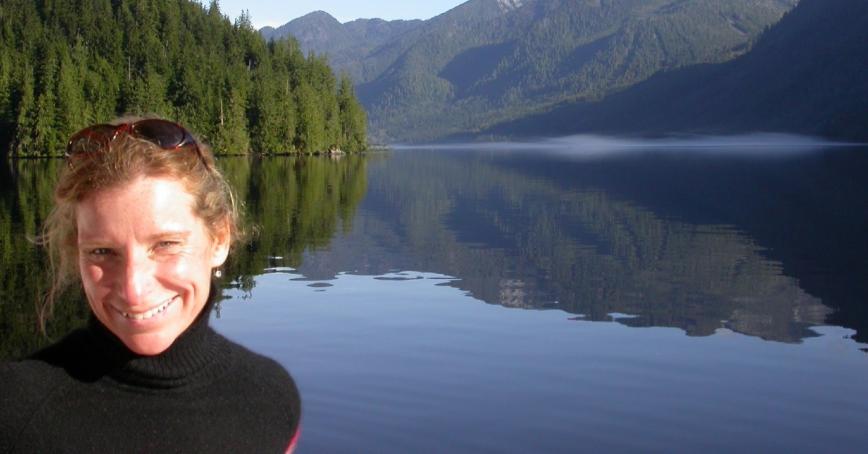Clicking on Clayoquot science
Topics
Featured
Share online

When the pandemic got in the way of the hands-on science and technology outreach programs she’s led for most of the past decade in B.C. coastal communities, Royal Roads marine geologist Prof. Audrey Dallimore and her six partner organizations asked, “What do we do now?”
They turned to StoryMaps, a new interactive digital map creation platform from the geographic information system company Esri. The platform – kind of a turbocharged version of PowerPoint – turned out to be a pandemic-proof tool for sparking interest in science and conservation among a wide audience – from kids in classrooms to tourists drawn to the natural beauty of the west coast of Vancouver Island.
“The (ArcGIS) StoryMaps program is publicly available for free, and the basic version doesn’t need an expensive user license. It’s only been around for about 18 months,” Dallimore says. “So we jumped on it. Considering we’re trying to do so much online these days, it has really become an excellent fit.”
The PromoScience Clayoquot Biosphere StoryMaps Collection brings together initiatives led by the Clayoquot Biosphere Trust, West Coast N.E.S.T., Association of Wetland Stewards of Clayoquot and Barkley Sounds, Raincoast Education Society, Strawberry Isle Marine Research Society, and the Cedar Coast Field Station.
Visitors can learn about a variety of species and ecosystems (and the organizations and scientists that are studying them) from shorebird tracking and frog and salamander habitat to juvenile salmon health and the Kakawin (Bigg’s killer whales). The StoryMaps are enhanced with stunning images and engaging storylines.
Dallimore says the key is in providing engaging information about science research methods and monitoring taking place in local areas, especially for residents of smaller communities.
“We just try to go where people are, and this year it’s online,” she says. “The images and videos pull you right in. They can do an amazing job of piquing the interest of people, young people in particular.
“Nobody’s a professional photographer but most of us who do field work have some DIY training. These amazing images, sound files, videos – they’re all done by the scientists themselves.”
Project funding comes from the NSERC PromoScience program which first provided a grant to Royal Roads in 2010 and then consecutively from 2013. In that time, Dallimore and colleagues have provided hands-on learning experiences.
A highlight was the 2018 PromoScience Expedition, which saw the Canadian Coast Guard inshore research vessel, CCGS Vector, serve as an on-board community classroom on the docks in Bamfield, Port Alberni, Ucluelet and Tofino.
Encouraging science careers for everyone
A primary aim of NSERC PromoScience is to encourage more women and other traditionally underrepresented groups in science and technology such as Indigenous people to pursue careers in those professions.
“I just love that through the (site’s) pictures alone you can see the diversity represented by the local scientists engaged in those professions,” Dallimore says. “These are definitely career paths that women can be engaged in more commonly now. And all of our partners, particularly our lead partner the Clayoquot Biosphere Trust, are very much engaged with the local Indigenous people who have lived there for thousands of years. We’re really happy about that as well.”
With the site up and running, the team is reaching out to teachers as well as other community members. “We were thinking specifically of potential contributions to curriculums in middle through high school,” Dallimore says. “But we are also hoping that elementary school teachers, tourism organizations, and other NGOs can go through the maps and watch our videos or just enjoy the beautiful pictures and the captions. You can use them to the depth you prefer, or your level of engagement, or your age.”
Recently retired, Dallimore is now a Professor Emerita at Royal Roads. She continues to apply for grants, keep up her involvement in the PromoScience program, and share her passion for science, especially with young people.
“I recall being very young and very interested in where the water goes after it rains. I loved being outside. Sailing. Canoe tripping. When I found out that the things that I liked to do for fun could turn into a career, I was hooked,” Dallimore says. “Now there’s more inspiration and support for women to go into the sciences and technology than when I first began my training and I’m just hoping this project can be a part of that with the wonderful team we have put together for our StoryMaps.”
Update
Dr. Dallimore received supplemental funding from the NSERC Promoscience program and will be partnering with the Ucluelet Aquarium during Science Literacy Week, September 20-26 as part of her ArcGIS project. There will be both in-person and online activities where participants can learn about the negative effects of climate change and coastal development on the intertidal zone and the impact they have on the whole ocean.